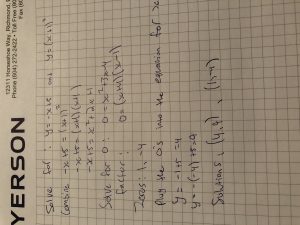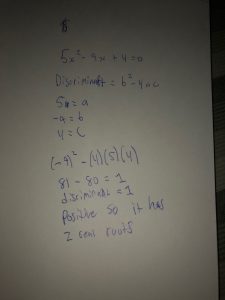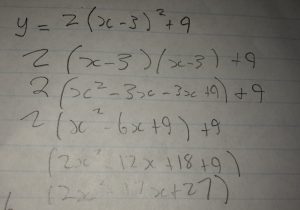This week we learned how to multiply rational expressions in fraction form. For this question you want to factor as much as possible. Once the equations is factored as much as possible, cross out like terms. 
Author: jacobs2015
Week 14 pre calc 11
 This week we learned how to simplify rational fractions. These are basically fractions that will involve factoring. A way to make these questions simpler is by crossing out common factors in the denominator and numerator of the fraction because if you divide them they’re just going to equal 1 anyways. We also learned that it is important to know the non-permissible values of x in the denominator. It is important to know because our denominator can never equal 0. therefore the non-permissible values of this expression are -5, -8, and 0.
This week we learned how to simplify rational fractions. These are basically fractions that will involve factoring. A way to make these questions simpler is by crossing out common factors in the denominator and numerator of the fraction because if you divide them they’re just going to equal 1 anyways. We also learned that it is important to know the non-permissible values of x in the denominator. It is important to know because our denominator can never equal 0. therefore the non-permissible values of this expression are -5, -8, and 0.
Protected: English 11 spoken word
Week 13 Pre Calculus 11
This week in math he learned how to graph reciprocal quadratic functions. When beginning these questions it is always easiest to start by graphing the original equation, in this example it is x squared minus 3. After graphing this draw a broken vertical line on the zeros or x-intercepts, because this graph has 2 solutions it will have 3 hyperbolas. The 2 “L” shaped hyperbolas hover right above the x-axis and almost touching the broken lines. The hyperbola on the bottom follows the same rules except it’s on the other side of the broken line.
Pre calc week 12
 This week in precalc we learned how to solve 2 inequalities by combining the equations. this only works when the equations have 2 variables. An important part of this process is when you send one equation to the other side of the equal sign, that they’re being added or subtracted properly or else the whole process will be ruined as the zeros will not be equal.
This week in precalc we learned how to solve 2 inequalities by combining the equations. this only works when the equations have 2 variables. An important part of this process is when you send one equation to the other side of the equal sign, that they’re being added or subtracted properly or else the whole process will be ruined as the zeros will not be equal.
Pre calc11 week 11 solving inequalities
Pre calc week 10 finding the discrimination 3.5
Back in unit 3 we learned what a discriminat is. A discriminat is “a function of the coefficients of a polynomial equation whose value gives information about the roots of the polynomial.” It helps us determine how many times the quadratic equation will hit the X axis. If the discriminant is positive there will be 2 roots (the parabola hits X twice), if the discriminant is equal to 0 there will be one root (hits X once), and if the discriminant is negative it will have no real roots (not touch the X axis).
Week 9 pre calc 11
this week in pre calc 11 we learned how to change quadratic equations into other equivalent forms. For my example I changed a standard or vertex form equation into a general form equation. To do so
1. Expand the squared brackets
2. BEDMAS so multiply the brackets together first
3. Multiply the inside of the brackets by 2
4. Bring the 9 inside of the brackets
5. You’ve completely changed a standard form into general form
English 11 Narative Essay edited
Narrative-Essay-Outline-z4t784 (1)-v0p1x6
Imthink my essay could have went a lot better. I feel that I needed an extra day to go through and edit it. There were a few grammatical errors that could’ve been fixed but also I would’ve been able to make it flow way better than it did. For next essay I will make sure to take time to edit it before handing it in because I did not have too much time to edit on this one. Also I will try to make the essay flow better.
Week 8- Finding the vertex of a parabola
On a parabola you will find many parts. But the most important part you need to find and understand is called the vertex. The vertex is the point where the two separate lines of the parabola come together and meet. The vertex can also tell you if your parabola has a maximum or minimum point. You can tell if it’s maximum or minimum by either looking at your graphed parabola or seeing what your a value equates too.
To find your vertex is very simple. Either check your graph where it lines up on the X and Y values or use the vertex equation. The vertex equation is -b/2a = X which will give you your X value. You will get your a and b values from your quadratic equation. Once you have your X value, you plug that back into your quadratic equation then solve to find your Y. Now With your X and Y values you will be able to graph your parabola.
In this graph you will know it has a minimum point because the A value is a positive. The vertex lines up on (0,0)
In this graph your A value is a negative so the vertex will be a maximum point. The vertex lines up on (1.3,7.1)






